Significant Mosques in Dubai: A Cultural Insight
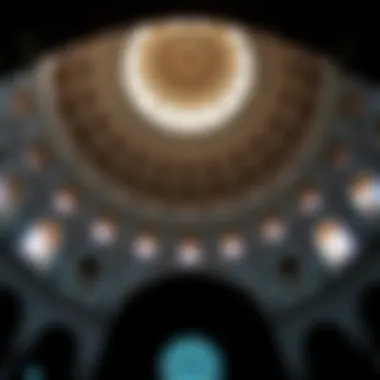

Intro
Dubai is a city known for its dazzling skyscrapers and luxurious lifestyle, but embedded within this glitzy facade are architectural marvels that resonate with spiritual and cultural significance. Specifically, the mosques of Dubai stand out not only for their striking designs but also for the rich histories they embody. These sacred spaces serve as more than just places of worship; they are community hubs that foster connections among people of diverse backgrounds.
As one wanders through this vibrant metropolis, the presence of these mosques is undeniable, each telling a unique story through its architecture and design. Whether it’s the opulence of the Sheikh Zayed Mosque or the serene simplicity of smaller, less known establishments, each site contributes to the ever-evolving narrative of Dubai.
In this article, we will embark on an exploration of Dubai’s architecturally significant mosques. We’ll delve into their design elements, historical contexts, and the cultural roles they play. We'll focus on their aesthetic appeal and examine how they are woven into the fabric of community life, shaping both faith and social engagement.
Through this journey, you will not only appreciate the beauty and grandeur of these structures but also gain insights into their deeper meanings, contributing to a broader understanding of Islamic architecture and its impact on Dubai’s identity.
The upcoming sections will provide a thorough examination of notable mosques in the area, shedding light on their architectural characteristics and historical significance, which shapes the collective memory of this modern city.
Foreword to Dubai's Religious Landscape
Dubai, with its ever-changing skyline, tells a story of ambition and modernity. But beyond the gleaming towers and bustling shops lies a profound narrative that shapes the core of its identity: the Islamic faith. Understanding the religious landscape of Dubai is vital for grasping the cultural intricacies and community dynamics that define this vibrant city. This narrative isn't just about mosques as structures; it's about the role they play in the social fabric, spiritual life, and even urban development within the emirate.
Importance of Mosques in Islamic Culture
Mosques are much more than places of worship; they are sanctuaries of learning, community hubs, and vital symbols of Islamic heritage. In the Islamic tradition, mosques serve as the heart of a Muslim community, facilitating prayer, education, and social gatherings. The weekly congregational prayers on Friday draw individuals together, reinforcing a sense of unity and belonging. Furthermore, many mosques have education programs, teaching Quranic studies and promoting Islamic values, which ensure the transmission of beliefs to younger generations.
In Dubai, the mosques reflect not only the religious practices but also the cultural diversity of its population. These structures often symbolize the architecture of the region, incorporating intricate designs and artistry that echo Islamic motifs. This symbolism transcends mere aesthetics; it showcases the shared values and collective identity of the community.
Overview of Dubai's Mosques
When one looks at Dubai's mosques, a fascinating tapestry of architectural styles emerges, each differing from the others but sharing a common thread of Islamic inspiration. From the historic Al Fahidi mosque to the modern Sheikh Zayed Mosque, the variety showcases a blend of traditional influences and contemporary design.
- Grand Mosque: A focal point of worship and a beacon for pilgrims and tourists alike, known for its stunning presence.
- Jumeirah Mosque: Renowned for its beauty and approachability, it's a prime example of welcoming cultural dialogue.
- Sheikh Zayed bin Sultan Al Nahyan Mosque: This mosque stands as a testament to unity and artistic craftsmanship.
Each mosque serves as a reflection of its time, incorporating elements from the past while also adapting to modern needs. This evolution of Islamic architecture in Dubai mirrors the city’s own rapid growth, symbolizing how faith and progress can coexist. The convergence of culture, art, and religion in these spaces invites both reverence and curiosity, making them essential stops for anyone interested in understanding the full spectrum of what Dubai has to offer.
"Mosques in Dubai are a rich blend of history and modernity, standing firm as symbols of the city's rapid evolution while maintaining deep-rooted traditions."
In summary, the mosques of Dubai do not merely exist as places of prayer; they contribute significantly to the community landscape, offering insights into the broader socio-cultural context of the UAE. With each visit, one gains a deeper appreciation for the intricate relationship between faith, architecture, and community life in this dynamic city. The following sections will explore individual mosques in greater detail, highlighting their unique features and significance.
The Grand Mosque: A Beacon of Faith
The Grand Mosque stands as a testament to Dubai’s architectural splendor and its deep-rooted Islamic traditions. With its grandiose structure and iconic presence, it is not just a place of worship but also a significant landmark that resonates with the cultural heartbeat of the city. The mosque plays a vital role in the religious and social lives of Dubai’s residents and provides a serene space for spiritual reflection amidst the urban hustle.
Architectural Features
Dome Design
One of the most striking aspects of the Grand Mosque is its dome design. The dome, usually perched atop the main prayer hall, is a magnificent architectural feature that enhances the mosque's majesty. Characteristically, it is large and bulbous, often adorned with intricate patterns and calligraphy.
The dome represents the heavens in Islamic architecture. This direct link to spirituality serves an essential role in conveying the significance of faith to visitors. Plus, a well-designed dome helps to amplify sounds during prayers, creating a richer auditory experience.
However, crafting such grand domes can be a challenge. They require specialized engineering and materials to ensure longevity and stability, making them a costly yet worthwhile investment for architectural majesty.
Minaret Height
The minaret, rising proudly into the sky, is another hallmark of the Grand Mosque's architectural prowess. Its impressive height not only symbolizes a call to prayer but also serves as a visual anchor in Dubai’s skyline. A tall minaret can be seen from afar, guiding people to the mosque, and emphasizing the Islamic tradition of public prayer.
The minaret’s slender design often incorporates intricate carvings and beautiful tile work. Aesthetically, this height adds to the overall grandeur but also poses engineering challenges, especially considering wind loads and structural integrity. Nonetheless, this vertical emphasis is indeed beneficial, marking the mosque in view of all, offering a sense of belonging to the community.
Interior Aesthetics
The interior of the Grand Mosque is as breathtaking as its exterior. Lavish chandeliers, elaborate mosaics, and exquisite calligraphy create a warm, inviting atmosphere. The use of high-quality marbles adds to its opulence, making each step within the mosque a reflection of artistry.
Beyond aesthetic beauty, the layout encourages a communal worship experience. Open spaces are designed to accommodate large gatherings, inviting worshipers into a shared spiritual journey. However, like the dome and minaret, maintaining such beauty requires continuous effort and resources, from preservation strategies to regular cleaning and restoration work.
Historical Significance
Foundation History
The foundation of the Grand Mosque is rooted deeply in Dubai’s history. Established during a period of rapid development, it marked an important step towards shaping a religious identity in a predominantly nomadic society. The construction was spearheaded by the visionary leaders of that era, aiming to provide a spiritual hub for the community.
This foundational history speaks volumes about the societal shifts in Dubai, from its humble beginnings to becoming a global city. Understanding this context allows for a deeper appreciation of the Grand Mosque today, as it continues to be a pillar in the social fabric of the city.
Cultural Events Hosted
The mosque is not only a place of prayer but has evolved into a venue for cultural events as well. Concerts, exhibitions, and talks are often held here, promoting interfaith dialogue and community engagement. Hosting such events showcases the mosque's commitment to cultural representation, emphasizing its role in bridging gaps between diverse communities.
These cultural initiatives are more than just events; they breathe life into the walls that may otherwise only echo prayers. They encourage conversations among different faiths and foster an environment of understanding and respect. However, managing a busy event calendar can stretch resources, demanding careful planning and community involvement to keep the spirituality intact amidst the lively activities.
Visitor Information
Opening Hours
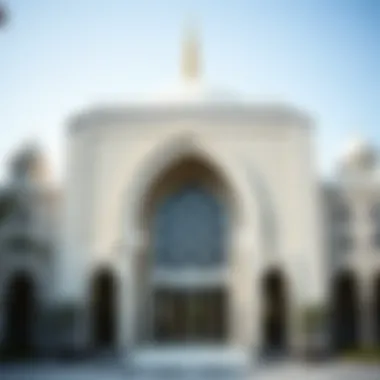
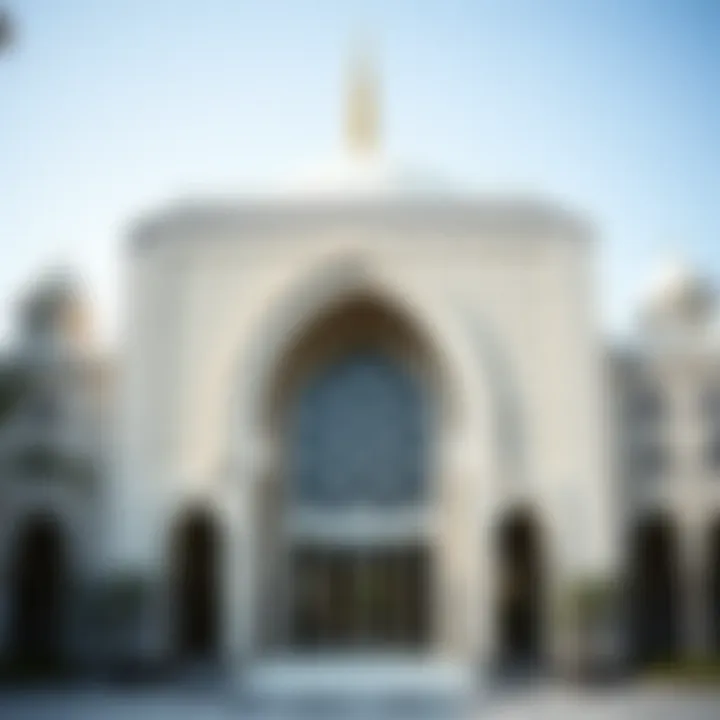
For those wishing to experience the beauty of the Grand Mosque, understanding its opening hours is critical. Typically, the mosque opens its doors daily but may have special hours for Fridays, in respect to the congregation's prayer time. Some festive periods too might alter the usual visiting schedule.
Being aware of these details enhances the overall visit and ensures guests do not miss out on the chance to soak in the ambiance. It becomes a brief reflection on the importance of planning, as unforeseen changes can lead to disappointment if pre-arranged visits do not align with these hours.
Guided Tours
Guided tours at the Grand Mosque offer an invaluable opportunity to delve into the rich history and intricate details of its architectural splendor. Knowledgeable guides provide insights into the design, function, and significance of the mosque, transforming a mere visit into an educational experience.
Taking part in a guided tour is beneficial as it enriches the visitor experience, providing context that might be overlooked when wandering alone. However, these tours can become crowded during peak tourist seasons, leading to a more hurried experience. Advance booking, therefore, is advisable to ensure a spot and alleviate the pressure of timing during the visit.
"The Grand Mosque is not just a building; it is a narrative chronicling Dubai's evolution, faith, and community."
In summary, the Grand Mosque stands tall not only as a religious structure but also as an essential part of Dubai's cultural identity. Its distinct architectural features, historical roots, and community roles weave a rich tapestry that continues to evolve in a modern world.
Jumeirah Mosque: An Architectural Gem
The Jumeirah Mosque stands as a potent symbol of Dubai's rich cultural heritage and religious architecture. Its distinctive design and welcoming approach epitomize what makes it an architectural marvel. Made with white stone, this mosque reflects the beauty of Islamic architecture and showcases the excellent craftsmanship found throughout Dubai. Unlike many other structures in the city, Jumeirah Mosque is open to non-Muslim visitors, making it a unique destination for tourists eager to delve into the spiritual and cultural fabric of the region.
Touristic Appeal
Visitor Programs
Visitor programs at the Jumeirah Mosque are specially tailored to provide insights into the Islamic faith. Conducted by knowledgeable guides, these programs are a blend of sightseeing and educational experience. One of the standout characteristics of these programs is their accessibility; they offer engaging sessions explaining Islamic history, architecture, and the mosque's significance. This inclusive approach is beneficial as it encourages greater understanding and appreciation for diverse cultures.
A unique feature of the visitor programs includes the chance to participate in a Q&A session with the guides after the tour. This not only allows for dialogue but also enriches the experience through interaction. Attendees frequently report feeling more enlightened and respectful towards Islamic traditions as a result. However, one might find that group sizes can on occasion be larger than ideal, slightly detracting from the personalized experience.
Cultural Dialogues
Cultural dialogues hosted at the Jumeirah Mosque are another stroke of brilliance, fostering understanding between different communities. These dialogues invite participants from various cultural and religious backgrounds, showcasing the mosque's commitment to interfaith harmony. The key characteristic of these conversations is their facilitation of candid discussions that transcend cultural barriers. It serves as a unique platform where people can engage openly on sensitive subjects in a respectful manner.
The distinct feature of cultural dialogues is their adaptability to the audience's interests. Whether focused on social issues or theological discussions, these dialogues promote collective learning. One could say they help build bridges between communities, demonstrating the mosque's role as a beacon of unity. The downside could be that such events require careful management to ensure all voices are heard fairly, which sometimes proves a challenge in larger groups.
Design Influences
Fatimid Architecture
The architectural design of the Jumeirah Mosque draws heavily from Fatimid architecture, a style recognized for its grandeur and elegance. Fatimid architecture typically showcases intricate detail and significant use of light, creating an inviting atmosphere. This connection to historical influences enhances the allure of the mosque, allowing visitors to appreciate not just the structure itself, but its transformational journey through time.
A distinguishing aspect of Fatimid architecture is its harmonious proportions and geometric patterns, which are evident in the mosque's design. This attention to detail contributes to its cultural significance, making it one of the finest examples reflecting Islamic artistry. There's a challenge, though. Maintaining these intricate features requires constant preservation efforts, which can be demanding for the community.
Color Palette
The color palette of the Jumeirah Mosque is another notable element that enhances its architectural charm. The soft hues of white and cream, often accompanied by shades of azure, create a calming ambiance. This choice not only amplifies the mosque's beauty but also aligns with the cultural aesthetics typical of Islamic architecture.
The unique feature of this color palette is how it interacts with natural light, changing the mosque's appearance through different times of the day. Visitors frequently note the serene quality this brings to their experience. Importantly, the use of such colors also serves a functional purpose, helping to keep the structure cooler in the intense summer heat. However, as with any design choice, maintaining these shades can require frequent upkeep, especially considering Dubai's climate.
"The Jumeirah Mosque not only represents architectural ingenuity but also embodies the spirit of inclusivity and understanding within the community."
This unique interplay between aesthetics, interactivity, and cultural significance makes Jumeirah Mosque a true gem in the urban landscape of Dubai.
Sheikh Zayed bin Sultan Al Nahyan Mosque: A Testament to Unity
The Sheikh Zayed bin Sultan Al Nahyan Mosque stands as an emblem of cohesion and cultural representation in Dubai’s intricate religious tapestry. Notably, it mirrors the unity sought in community life, reflecting not only the architectural brilliance but also the spirit of inclusivity. This mosque is more than just a place for prayers; it transcends into a project embodying both historical significance and a modern vision for interfaith harmony.
Symbolism in Design
Patterns and Calligraphy
The rich patterns and exquisite calligraphy adorning the mosque’s walls tell a profound story about Islamic heritage. These elements are not just decorative; they serve a greater purpose of connecting worshippers to centuries of spiritual tradition. The intricate geometric designs are hallmark of Islamic art, created to inspire reflection and evoke the infinite nature of creation.
One striking characteristic of these patterns is their ability to convey complex ideas through simple yet captivating designs. The unique feature here lies in the calligraphy, featuring verses from the Quran, beautifully etched in flowing Arabic script. This combination makes them a beneficial choice for discussing the mosqu's unity theme.
The advantage of having such art is twofold: it beautifies the space while helping visitors to engage more deeply with their faith. However, the complexity of these designs can overwhelm some, potentially distancing rather than inviting.
Use of Space
Examining the use of space reveals another layer of meaning within the mosque’s architecture. The thoughtful arrangement offers ample room for worship while seamlessly integrating communal areas. This reflects a foundational principle in Islamic architecture: connection and accessibility.
A key characteristic is the spacious design that accommodates a significant number of worshippers without compromising comfort or intimacy. The expansive interior promotes a feeling of belonging, essential in a community-centered place. The mosque’s layout incorporates specific areas for specialized functions—like educational purposes and cultural dialogues—making it an advantageous element of this architectural wonder. However, one might argue that such vastness can risk isolating individuals if not designed with careful consideration of congregation dynamics.
Community Role
Educational Initiatives
At the heart of the Sheikh Zayed Mosque's mission lies its emphasis on educational initiatives. These programs aim to enrich the community’s understanding of Islam and other cultures through informative workshops and guided tours. They facilitate a learning atmosphere that welcomes everyone, fostering dialogue about faith and traditions.
This approach is beneficial, serving not only to educate but also to humanize the Islamic faith among diverse audiences. The unique feature lies in specialized curriculums that cater to varying age groups, thus promoting inclusivity. However, keeping such initiatives well-resourced and up-to-date remains a challenge in a rapidly evolving Dubai.
Interfaith Outreach
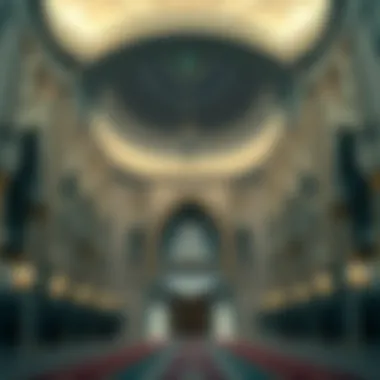
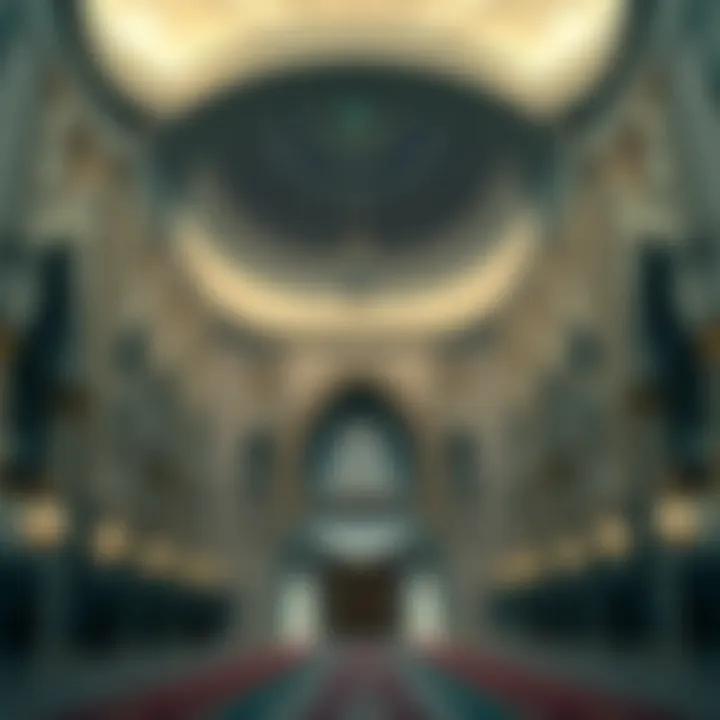
Interfaith outreach is another vital aspect of the mosque’s community role, promoting core values of tolerance and understanding. The mosque regularly hosts interreligious gatherings, allowing individuals from different backgrounds to engage in dialogue, thereby fostering friendships and reducing misconceptions.
What makes this outreach particularly striking is the welcoming atmosphere created to encourage open discussions about faith. This initiative’s benefits extend beyond spiritual upliftment; they build bridges between communities, promoting peace in a multicultural context. One downside, though, could be the potential for misunderstandings or misinterpretations, requiring facilitators to navigate those conversations with care.
In summary, the Sheikh Zayed bin Sultan Al Nahyan Mosque exemplifies how architecture can transcend mere structure, shaping community life through design and purpose. It fosters unity, learning, and interfaith relationships, ensuring that mosques are not just places of worship, but also crucial elements of urban life in Dubai.
Al Farooq Omar Bin Al Khattab Mosque: A Blend of Tradition and Modernity
The Al Farooq Omar Bin Al Khattab Mosque stands as a striking testament to the confluence of traditional Islamic architecture and contemporary design. Situated in the bustling heart of Dubai, it embodies both an architectural marvel and a communal hub. This mosque is not just a place of worship; it serves as a space for cultural exchange and social engagement, reflecting the grand narrative of Dubai’s growth while honoring its roots.
Cultural Artifacts
Art Pieces Displayed
The Al Farooq Mosque features a diverse collection of art pieces that capture the essence of Islamic creativity and aesthetics. Among these, intricate calligraphic panels stand out, each one showcasing verses from the Quran rendered in stunning detail. These pieces serve as a bridge to the spiritual, elevating the visual experience of visitors. The mosque houses a range of artworks that date back several eras, offering a visual timeline of Islamic art's evolution. This blend of historical and contemporary styles not only enriches the mosque’s aesthetic value but also enhances visitor experience, making it a popular landmark within Dubai’s cultural landscape.
One unique feature of the displayed art is its accessibility; the pieces are not confined to any specific area but are spread throughout the mosque. This encourages visitors to engage with them in a more personal way. Such dynamic placements invite reflection and dialogue, making the mosque a welcoming space for all.
Historical Texts
The mosque also hosts a collection of historical texts that provide insight into Islamic teachings and local history. These texts, available for public viewing, serve as an educational resource for those interested in understanding the depth of Islamic tradition. Their presence within the mosque underscores the commitment to education, as they not only enrich the spiritual environment but also foster an appreciation for the literary heritage of the Muslim world.
A notable characteristic of these historical texts is their focus on local narratives that connect the community to its past. This lends a unique aspect to the mosque, distinguishing it as not merely a place for prayer but also a center for cultural learning. Visitors can engage with these texts through guided readings or workshops, further enhancing the community's understanding of its roots.
Community Engagement
Volunteer Programs
Volunteering at the Al Farooq Mosque is more than a mere act of service; it embodies the spirit of community unity. The mosque runs numerous volunteer programs that encourage individuals from all walks of life to contribute their time and skills, creating a vibrant community fabric. These programs range from educational initiatives to community clean-up days, and they cater to various interests and skills.
One of the significant benefits of these volunteer opportunities is the chance for individuals to connect with each other. They provide a platform for social interaction, fostering friendships and networks that extend beyond the mosque walls. By participating in these programs, volunteers often express a deeper sense of belonging, underscoring the mosque's role as a communal hub.
Charity Drives
Charity drives organized by the mosque further amplify its impact on the community. These initiatives target diverse aspects of community welfare, from providing food supplies to those in need to sponsoring educational programs for underprivileged children. The drives garner enthusiastic support from local residents and businesses alike, highlighting the mosque's pivotal role in addressing social issues.
A key characteristic of these charity events is their transparency and inclusiveness, promoting a culture of philanthropy where everyone is invited to contribute in whatever way they can. This approach not only enhances the mosque's standing within the community but also empowers individuals to act on their civic responsibilities. The unique feature of these drives is their focus on seasonal themes, such as Ramadan or Eid, which creates a dynamic and timely community engagement strategy. Through these efforts, the mosque underscores a commitment to uplift all members of society, threading a collective responsibility throughout its initiatives.
"The mosque not only serves its spiritual purpose but also acts as a catalyst for community engagement and cultural education."
The Al Farooq Omar Bin Al Khattab Mosque exemplifies how faith and community intertwine, creating a space that is as much about cultural growth as it is about spiritual reflection. This blending of tradition and modernity enriches the urban fabric of Dubai, making it a crucial feature in the city’s evolving narrative.
Safa Park Mosque: Integration with Nature
The Safa Park Mosque stands as a prime example of how modern architecture can harmonize with the natural environment. Situated amid the lush landscapes of Safa Park, this mosque is not merely a place of worship; it acts as a serene oasis that enhances the overall experience of its surroundings. The mosque's thoughtful design encourages visitors to reflect on both their spiritual beliefs and their connection to nature.
Eco-Friendly Design
Sustainable Materials
Using sustainable materials is not just a trend but a necessity for creating a more eco-conscious architectural landscape. In the context of Safa Park Mosque, these materials are chosen for their minimal environmental impact. For instance, local stone and reclaimed wood are prominently featured in the mosque's structure, reducing the need for transportation and the associated carbon footprint. This aspect is more than just aesthetic; it embraces a philosophy that aligns with the tenets of responsible living within Islamic teachings.
One key characteristic of these materials is their durability, ensuring that the mosque remains a lasting symbol of faith and environmental respect. The choice of sustainably sourced materials reflects a growing awareness within the community about the importance of environmental stewardship. This mosque encourages visitors and worshippers to engage in conversations surrounding sustainability, laying a foundation for a future where faith and ecological mindfulness coexist.
Energy Efficiency
Energy efficiency at the Safa Park Mosque is noteworthy, featuring design elements that optimize energy use throughout the structure. Large windows allow natural lighting to illuminate the prayer halls, greatly reducing reliance on artificial lights during the day. The strategic placement of these windows also promotes natural airflow, further reducing the need for air conditioning.
This focus on energy efficiency makes the mosque a beneficial choice for the community. The mosque not only serves its spiritual purposes but also contributes positively to the city’s energy conservation efforts. It provides a model for other buildings in Dubai—showing that integrating green technologies is not only feasible but deeply rewarding in both social and environmental contexts.
Spiritual Experience
Meditative Spaces
The meditative spaces within Safa Park Mosque are designed to foster reflection and spiritual tranquility. These areas are intentionally separated from the hustle of daily life, allowing individuals to find solace and peace, an essential element in any act of worship. Meditation rooms are included in the mosque's design, featuring soft colors and minimalistic layouts that invite stillness and introspection.
A unique feature of these spaces is their adaptability—designed to host both personal meditation moments as well as group activities. This versatility enhances the communal experience while allowing for individual reflection, making it not just a congregation area but a nurturing ground for spiritual growth.
Gardens and Serenity
The gardens surrounding Safa Park Mosque play a pivotal role in promoting serenity, acting as a buffer between the chaos of city life and the tranquility sought through faith. These gardens are meticulously landscaped with local flora that not only beautifies but also enhances biodiversity. Visitors often stroll through these serene spaces before or after prayers, experiencing a deeper connection to nature.
This integration of gardens serves a dual purpose: it beautifies the mosque and acts as a serene retreat for the community. It helps in promoting mental well-being and inviting people to explore their spirituality in a calming environment, breaking the mold of traditional mosque designs.
"Safa Park Mosque is more than just a space for worship; it embodies a vision of sustainable living intertwined with spiritual exploration."
The Role of Mosques in Dubai's Urban Development
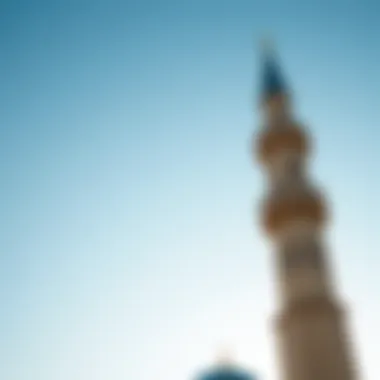

The role of mosques in Dubai extends far beyond mere places of worship; they are vital components of the urban landscape that shape the city's social fabric. As Dubai continues to grow, mosques contribute to urban development not just architecturally but socially and culturally as well. These structures act as a bridge between tradition and modernity, enhancing community engagement while meeting the needs of a diverse populace.
Influence on Local Communities
Community Centers
Mosques function as community centers, providing a wide array of services that benefit local residents. These centers not only hold prayers but also offer classes, workshops, and events that foster social cohesion. The welcoming nature of these facilities encourages participation throughout the community, making them a beloved choice among families and individuals alike.
An example can be found in the community programs led by mosques like the Jumeirah Mosque, which often engage youth in after-school activities, spiritual education, and cultural events. The unique aspect of these community centers is their ability to adapt. Whether it's hosting interfaith dialogues or social gatherings, they create a shared space for understanding and unity. However, some challenges remain, such as the need for continuous funding and resources to maintain these valuable programs, especially in a rapidly evolving urban environment.
Social Services
Social services provided by mosques play a crucial role in addressing the needs of vulnerable populations in Dubai. Many mosques operate food banks, health clinics, and counseling services, catering to both locals and expats. This aspect emphasizes not only the mosques' function as spiritual hubs but also as key players in social welfare.
Take the example of the Sheikh Zayed Grand Mosque, which regularly organizes charity drives and health awareness campaigns. These initiatives reflect a commitment to social responsibility and support for those in need. The unique feature of these social services is their inclusivity, ensuring that help reaches beyond faith lines. Yet, there's the constant quest for resources and volunteer support, which can at times limit the reach of these essential services.
Architectural Impact
Landmark Status
Mosques in Dubai often gain landmark status, drawing visitors and serving as symbols of the city's cultural identity. Structures like the Sheikh Zayed bin Sultan Al Nahyan Mosque not only dominate the skyline but also symbolize the blend of rich Islamic traditions and modern architectural techniques. This status attracts both tourists and locals, highlighting how these buildings contribute to the city’s image.
The architectural beauty of these landmarks serves a dual purpose: they are sites of worship and cultural attraction. The unique eye-catching designs, from intricate calligraphy to majestic domes, make them remarkable examples of Islamic architecture. However, their popularity can sometimes lead to overcrowding, which presents challenges for community members who seek solace in their local mosques.
Urban Planning Contributions
Mosques influence urban planning significantly, often dictating the layout of nearby residential areas and amenities. Well-planned mosques are located in accessible areas, encouraging community gatherings and social interaction. The urban footprint left by these sacred spaces often extends to parks, educational institutions, and food markets, enhancing the area’s livability.
The Al Farooq Omar Bin Al Khattab Mosque is a perfect example where its location encourages cohesive community interaction. Mosques also influence zoning regulations, which prioritize the preservation of cultural heritage sites while accommodating new growth. However, striking a balance can occasionally lead to conflicts between modern development needs and the conservation of historic sites.
In summary, mosques in Dubai play multi-faceted roles in the city's urban development, enhancing community engagement, providing essential services, and contributing to the architectural narrative of the region. The delicate interplay between tradition and modernity at these sites continues to shape Dubai's vibrant cultural tapestry.
Challenges Facing Mosques in Modern Dubai
As the city of Dubai evolves rapidly, its mosques face a multitude of challenges that require a careful balancing act between tradition and modernity. This section delves into these intricate dynamics, examining how the faithful must navigate a landscape marked by cultural shifts, population growth, and secularization. It captures the essence of how mosques can remain pillars of the community while adapting to contemporary needs.
Balancing Tradition and Modernity
Preservation Efforts
In a city known for its skyscrapers and bustling trade, the preservation of traditional mosque architecture is vital. Preservation efforts focus on maintaining the unique architectural features and spiritual significance of mosques as Dubai develops into a modern metropolis. One key characteristic of these efforts is the meticulous restoration of intricate tile work and calligraphy that symbolizes Islamic art.
These preservation initiatives not only safeguard the aesthetic integrity but also enhance community pride. For example, when Al Farooq Omar Bin Al Khattab Mosque underwent restoration, it kept its original blend of traditional styles while updating facilities for modern worshippers. Thus, while preserving the mosque's heritage, it also addressed practical needs. However, the disadvantages may include high costs and the occasional pushback from developers seeking to convert land for new projects.
Cultural Representation
Culturally, mosques serve as representations of Islamic values within a multicultural urban context. Cultural representation at these sites is essential in fostering dialogue between diverse communities. One significant aspect of this representation is how mosques can host interfaith dialogues, allowing various faiths to come together and share ideas.
This approach not only strengthens community ties but also promotes understanding in a world full of differences. Such cultural representation is popular as it demonstrates the tolerant spirit of Dubai, yet it may also come with challenges. Some community members may feel that blending cultures dilutes their religious identity. Those concerns need to be thoughtfully addressed to ensure that mosques remain safe havens for all.
Addressing Growth and Demand
Community Needs Assessment
As Dubai's population swells, mosques must assess community needs to stay relevant and functional. A community needs assessment reveals the demand for enhanced services, such as educational programs and social engagement initiatives. Key characteristics of these assessments include surveys and community meetings to gather insights and preferences directly from local worshippers.
These efforts are beneficial as they actively involve the community in the evolution of their spiritual spaces. However, the process can be time-consuming, requiring significant outreach and follow-ups to ensure a wide representation of voices. Unquestionably, a thorough needs assessment helps mosques adapt better to the dynamic demographics and growing religious requirements of the region.
Expansion Plans
Expanding mosque facilities can meet the increasing demand for space due to a burgeoning population. Expansion plans often include additional prayer areas, community centers, and educational facilities. The key characteristic of these plans is often community-focused, aiming to provide multifunctional spaces that cater not only to worship but also to social and educational functions.
Such expansion plans are advantageous because they enhance accessibility for a larger number of worshippers, offering both practical benefits and promoting greater community involvement in mosque life. Nonetheless, expansion can also ignite debates over land use and financial resource allocation, particularly in a city that continues to develop vertically rather than horizontally.
In summary, the challenges facing mosques in modern Dubai highlight a critical junction of cultural preservation, community needs, and the pressures of urbanization.
As we continue to explore the significance of these architectural wonders, understanding these challenges is key to appreciating the ways in which mosques adapt and thrive in a vibrant, ever-changing city.
Culmination: The Enduring Significance of Mosques in Dubai
The mosques scattered throughout Dubai are far more than mere places of worship; they serve as histrionic landmarks contributing profoundly to the cultural fabric of the city. It’s crucial to appreciate how these architectural masterpieces embody the deeply rooted Islamic traditions while navigating the currents of modernity. The intricate designs, from the majestic domes to the elegant minarets, capture not only the aesthetic but the spiritual essence that resonates with both locals and visitors alike.
Cultural Heritage
Mosques play a pivotal role in preserving the cultural heritage of Dubai. Each mosque tells its own story, echoing the history and traditions of the Islamic faith and the local community. For instance, the Jumeirah Mosque stands as a prime example, with its Fatimid architecture reflecting the grandeur of Islamic artistry and historical significance. Their designs often incorporate local elements that connect them to the rich traditions of the Emirate.
- Architectural Significance: Every mosque features unique architectural elements that highlight the evolution of design philosophies in the Islamic world, particularly in the context of a rapidly modernizing city like Dubai.
- Educational Hub: Many mosques also function as educational hubs, providing essential religious and cultural education to citizens and expatriates alike. This educational role ensures that the younger generations remain rooted in their cultural identity.
Future Prospects
As Dubai continues to grow and evolve economically and socially, the role of mosques within the urban landscape is set to transform. The future of these structures lies in their ability to adapt while maintaining their core values, balancing tradition with progress.
- Sustainable Practices: Emerging trends show mosques adopting eco-friendly practices in their construction and maintenance, mirroring the broader global shift towards sustainability. A notable example would be the green initiatives seen in places like the Safa Park Mosque, where integration with nature reflects a conscious effort to harmonize with the environment.
- Community Focus: With increasing diversity in populations, mosques in Dubai are expected to enhance their outreach by promoting understanding and tolerance through interfaith dialogues and community programs.







